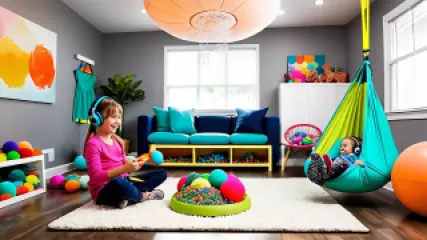10 Best Sensory Processing Therapy Tools for Kids
Sensory processing therapy is an essential part of many children's lives, especially those who struggle with sensory integration challenges. These therapies help to enhance a child's ability to process and respond to sensory information. Sensory processing techniques can range from simple exercises at home to more structured programs designed by sensory processing experts. In this article, we will explore the ten best sensory processing therapy tools for kids that can make a significant difference in their daily lives.
1. Weighted Blankets
Weighted blankets are a popular tool in sensory processing therapy. They provide deep touch pressure stimulation, which can have a calming effect on children with sensory processing difficulties. The gentle pressure can help to reduce anxiety and improve mood, making it easier for children to relax and fall asleep.
Benefits of Weighted Blankets
- Calming Effect: The deep pressure stimulation helps to calm the nervous system.
- Improved Sleep: Many children find it easier to fall asleep and stay asleep when using a weighted blanket.
- Anxiety Reduction: The gentle pressure can help to reduce feelings of anxiety and stress.
"Weighted blankets have been a game-changer for my son. He sleeps better and wakes up less anxious." Nina Evans
2. Sensory Swings
Sensory swings are another fantastic tool for sensory processing therapy. They provide vestibular input, which is crucial for balance and spatial orientation. Swinging can be both stimulating and calming, depending on the type of swing and the way it is used.
Types of Sensory Swings
- Hammock Swings: These provide gentle, soothing motion.
- Platform Swings: These offer more varied movement, including spinning and rocking.
- Pod Swings: These provide a cozy, enclosed space for children to relax.
Benefits of Sensory Swings
- Vestibular Input: Helps with balance and spatial orientation.
- Calming: Can help to reduce anxiety and hyperactivity.
- Stimulation: Can provide sensory input that some children crave.
"Our sensory swing has made a huge difference in our daughter's ability to regulate her emotions." Glen Robinson
3. Therapy Balls
Therapy balls, also known as exercise balls or stability balls, are versatile tools in sensory processing therapy. They can be used for a variety of exercises that help to improve balance, coordination, and core strength.
Uses for Therapy Balls
- Seating: Sitting on a therapy ball can help children to stay focused and engaged.
- Exercises: Various exercises can be performed to improve strength and coordination.
- Deep Pressure: Rolling over a therapy ball can provide deep pressure input.
Benefits of Therapy Balls
- Balance and Coordination: Improves these critical skills.
- Core Strength: Exercises on a therapy ball help to strengthen core muscles.
- Focus: Sitting on a therapy ball can help children to stay focused and attentive.
"Using a therapy ball has helped my child improve his balance and coordination significantly." Aubrie Casey
4. Noise-Canceling Headphones
For children with auditory sensitivities, noise-canceling headphones can be a lifesaver. They help to block out background noise, making it easier for children to focus and reducing sensory overload.
Benefits of Noise-Canceling Headphones
- Reduced Overload: Helps to prevent sensory overload by blocking out background noise.
- Improved Focus: Makes it easier for children to concentrate on tasks.
- Anxiety Reduction: Reduces anxiety caused by loud or unexpected noises.
"Noise-canceling headphones have made such a difference in my son's ability to handle noisy environments." Carroll Banks
5. Sensory Bins
Sensory bins are a fun and engaging way for children to explore different textures and sensations. They can be filled with a variety of materials, such as rice, beans, sand, or water beads, and provide endless opportunities for sensory play.
Materials for Sensory Bins
- Dry Rice or Beans: Provides a satisfying tactile experience.
- Sand: Great for digging and scooping.
- Water Beads: Offer a unique, squishy texture.
- Shaving Cream: Fun for messy, tactile play.
Benefits of Sensory Bins
- Tactile Exploration: Encourages children to explore different textures.
- Fine Motor Skills: Scooping, pouring, and digging help to develop fine motor skills.
- Imaginative Play: Sensory bins can inspire imaginative and creative play.
"Sensory bins have been a wonderful addition to our therapy routine. My daughter loves exploring the different textures." Nina Evans
6. Fidget Toys
Fidget toys are small, handheld objects that can help children to focus and self-regulate. They provide tactile and sensory input, which can be particularly helpful for children who struggle with attention and hyperactivity.
Types of Fidget Toys
- Stress Balls: Soft, squeezable balls that provide tactile input.
- Fidget Spinners: Spinning toys that can help to focus attention.
- Tangle Toys: Twisting and turning toys that provide continuous movement.
- Putty or Slime: Malleable substances that provide a unique tactile experience.
Benefits of Fidget Toys
- Focus: Helps children to concentrate on tasks.
- Self-Regulation: Provides an outlet for excess energy and anxiety.
- Tactile Input: Satisfies the need for tactile stimulation.
"Fidget toys have been incredibly helpful for my son. They help him to stay focused and calm during school." Glen Robinson
7. Compression Clothing
Compression clothing, such as vests or shirts, provides deep pressure input, similar to a weighted blanket. This can be particularly soothing for children with sensory processing challenges, helping them to feel more grounded and secure.
Benefits of Compression Clothing
- Calming Effect: The deep pressure input can help to calm the nervous system.
- Improved Focus: Many children find it easier to concentrate when wearing compression clothing.
- Anxiety Reduction: The gentle pressure can help to reduce feelings of anxiety.
"Compression clothing has been a great addition to our sensory toolkit. It helps my daughter feel more secure and focused." Aubrie Casey
8. Chewable Jewelry
Chewable jewelry is designed for children who need oral sensory input. These items are made from safe, non-toxic materials and can be chewed on without causing harm. They provide a discreet way for children to satisfy their need for oral stimulation.
Benefits of Chewable Jewelry
- Oral Stimulation: Provides a safe outlet for children who need to chew.
- Focus and Concentration: Chewing can help some children to focus and concentrate.
- Anxiety Reduction: The act of chewing can help to reduce anxiety and stress.
"Chewable jewelry has been a lifesaver for my son. It helps him to stay calm and focused during stressful situations." Carroll Banks
9. Visual Timers
Visual timers are helpful tools for children who have difficulty understanding the passage of time. They provide a visual representation of time, making it easier for children to manage transitions and stay on task.
Benefits of Visual Timers
- Time Management: Helps children to understand and manage the passage of time.
- Transitions: Makes transitions between activities smoother and less stressful.
- Focus: Helps children to stay focused and on task.
"Visual timers have made a huge difference in our daily routine. They help my daughter to understand time and stay on track." Nina Evans
10. Balance Boards
Balance boards are excellent tools for improving balance, coordination, and core strength. They provide vestibular input and can be used for a variety of exercises that enhance sensory processing and motor skills.
Benefits of Balance Boards
- Balance and Coordination: Helps to improve these critical skills.
- Core Strength: Exercises on a balance board help to strengthen core muscles.
- Vestibular Input: Provides important sensory input for balance and spatial orientation.
"The balance board has been a great addition to our therapy sessions. It has helped my son improve his balance and coordination." Glen Robinson
Conclusion
Sensory processing therapy tools can make a significant difference in the lives of children with sensory processing challenges. From weighted blankets to sensory bins, each tool offers unique benefits that can help children to feel more calm, focused, and secure. By incorporating these tools into their daily routines, parents and therapists can provide the sensory input that children need to thrive.
Whether you're just starting out with sensory processing therapy or looking to expand your toolkit, these ten tools are a great place to start. Remember, every child is unique, so it's important to find the tools that work best for your child's individual needs. With the right support and resources, children with sensory processing challenges can achieve their full potential.
Sensory processing therapy is not just about the tools; it's about understanding and supporting the unique sensory needs of each child. By doing so, we can help them to navigate the world with confidence and ease.
If you have any experiences or tips to share about sensory processing therapy tools, please feel free to leave a comment below. Your insights could help other parents and caregivers who are on this journey.






